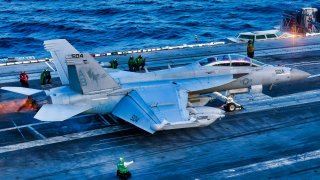Forget the F-35: Boeing's EA-18G Growler Might Be the Navy's Most Important Jet
The Boeing EA-18G Growler, introduced in 2009, is a specialized electronic warfare (EW) variant of the F/A-18F Super Hornet, sharing 90% of its components.
Summary and Key Points: The Boeing EA-18G Growler, introduced in 2009, is a specialized electronic warfare (EW) variant of the F/A-18F Super Hornet, sharing 90% of its components.
-Equipped with up to five ALQ-99 jamming pods, the Growler is designed for escort and radar jamming to disrupt enemy radar systems.
-Powered by two F414-GE-400 turbofan engines, it reaches speeds of Mach 1.8. Despite lacking guns, it features nine hardpoints for fuel and ordnance.
-Though the Growler has seen limited combat, it has been deployed in operations such as Libya’s no-fly zone and defending Red Sea shipping lanes from Houthi rebel attacks.
One U.S. Navy jet that gets lost in the mix is the Boeing EA-18G Growler.
A specialized version of the F/A-18F Super Hornet two-seater, the Growler is built specifically for electronic warfare (EW). And while the Growler has been in service since 2009, you are still far more likely to hear about the Super Hornet or the F-35 Lightning II.
Introducing the Growler
The Growler, as you might expect, flies comparably to the Super Hornet. The two jets share 90 percent commonality, including the airframe and the Raytheon AN/APG-79 AESA radar. But instead of performing air-to-air or air-to-ground missions like the Super Hornet, the Growler performs escort jamming and radar jamming/deception. Basically the Growler sends out radio signals that saturate radar receivers and make detection of something like the Super Hornet less likely. To perform a radar jamming mission, the Growler can be outfitted with up to five ALQ-99 jamming pods.
The ALQ-99 is an electronic warfare system that was found on the Growler’s predecessor, the EA-6B Prowler, a four-seat EW version of the A-6 Intruder attack aircraft. The ALQ-99 features receiver equipment and antennas mounted in a fin-tip pod, as well as jamming transmitters and exciter equipment in underwing pods. The ALQ-99 gives an aircraft the ability to detect and identify radio frequency signals and to collect signals intelligence. But the ALQ-99 hasn’t always performed up to the Navy’s standards. The jammer pod has suffered frequent failures that scuttle Growler missions. Accordingly, the Navy is considering upgrades to the system.
In addition to the ALQ-99, the Growler can be outfitted with a Raytheon ATFLIR (forward looking infrared) pod. The ATFLIR was only added to the Australian Air Force’s Growlers after the 2011 Libyan civil war. With an ATFLIR, the Australian Growler’s are able to visually confirm targets.
Flying the Growler
The relatively new Growler has participated in limited combat. It was deployed to enforce a UN no-fly zone over Libya in 2011, and to participate in Operation Prosperity Guardian, defeding Red Sea shipping lanes from Houthi rebel attacks.

The Growler relies on two General Electric F414-GE-400 turbofan engines, which can provide 14,000 pounds of thrust dry and 22,000 pounds of thrust with afterburner. The two F414s allow the Growler to hit top speeds of Mach 1.8 and a service ceiling of 50,000 feet with a thrust-to-weight ratio of 0.93.
You won’t find any guns on the Growler. But you will find nine hardpoints, six under the wing and three under the fuselage, which can handle nearly 18,000 pounds of fuel and ordnance. The wing-tip rails used on the Super Hornet to carry the AIM-9 Sidewinder have been replaced on the Growler with the AN/ALQ-218 detection pod. Internally, the Growler can carry about 14,000 pounds of fuel. Externally, the Growler can carry three tanks for an extra 10,000 pounds of fuel.
About the Author: Harrison Kass
Harrison Kass is a defense and national security writer with over 1,000 total pieces on issues involving global affairs. An attorney, pilot, guitarist, and minor pro hockey player, Harrison joined the US Air Force as a Pilot Trainee but was medically discharged. Harrison holds a BA from Lake Forest College, a JD from the University of Oregon, and an MA from New York University. Harrison listens to Dokken.
Image Credit: Creative Commons.


